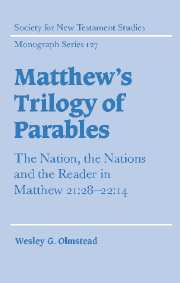Book contents
- Frontmatter
- Contents
- Acknowledgements
- Part one Prolegomena
- Part two The trilogy in narrative-critical perspective
- 3 Jesus' encounter with Israel: the nation, its leaders and their people
- 4 Jesus and the nations: characterisation, plot and the reception of Matthew 21.28–22.14
- 5 A narrative-critical reading of the trilogy
- Part three The trilogy in redaction-critical perspective
- Appendix The text of the parable of The Two Sons
- Notes
- Bibliography
- Index of passages
- Index of selected topics and modern authors
5 - A narrative-critical reading of the trilogy
Published online by Cambridge University Press: 22 September 2009
- Frontmatter
- Contents
- Acknowledgements
- Part one Prolegomena
- Part two The trilogy in narrative-critical perspective
- 3 Jesus' encounter with Israel: the nation, its leaders and their people
- 4 Jesus and the nations: characterisation, plot and the reception of Matthew 21.28–22.14
- 5 A narrative-critical reading of the trilogy
- Part three The trilogy in redaction-critical perspective
- Appendix The text of the parable of The Two Sons
- Notes
- Bibliography
- Index of passages
- Index of selected topics and modern authors
Summary
If chapters 1 and 2 were devoted, respectively, to questions of method and of the origin of the trilogy, and chapters 3 and 4 to exploring the role that the wider narrative plays in shaping the reader's response to these parables, then chapters 5 and 6 shift the focus to the trilogy of parables itself. This chapter offers a narrative-critical reading of these parables. In accord with the conclusions drawn in chapter 2, I make a conscious attempt here to read the parables as a trilogy and, in line with the argument developed in chapter 1, I attempt to elucidate the responses that the trilogy seems designed to evoke from the reader. In this regard, I shall be especially interested in the inclusive nature of these parables.
In his 1990 monograph D. Howell suggests that Matthew's narrative is an ‘inclusive’ story in that it invites its readers ‘to appropriate and involve themselves in the story and teaching of the Gospel’. Howell turns from this observation to formulate the questions that set the agenda for his study: ‘Who is “included” in Matthew's story and how are they “included”? Are literary techniques used which help structure a reader's response to the story and its message? If so, how do they function?’ These questions will also occupy my attention. In this chapter I examine the nature of the evangelist's rhetoric and seek to isolate the responses that this rhetoric seems designed to elicit.
- Type
- Chapter
- Information
- Matthew's Trilogy of ParablesThe Nation, the Nations and the Reader in Matthew 21:28-22:14, pp. 98 - 130Publisher: Cambridge University PressPrint publication year: 2003



